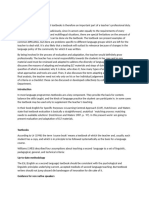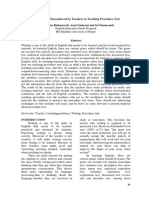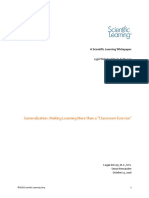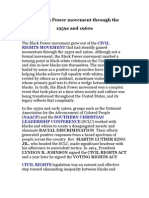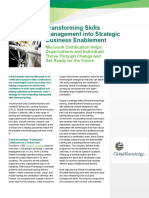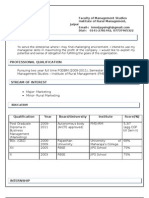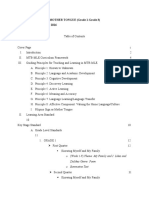Language Classroom Assessment: The Electronic Journal For English As A Second Language
Language Classroom Assessment: The Electronic Journal For English As A Second Language
Uploaded by
Hamda NasrCopyright:
Available Formats
Language Classroom Assessment: The Electronic Journal For English As A Second Language
Language Classroom Assessment: The Electronic Journal For English As A Second Language
Uploaded by
Hamda NasrOriginal Title
Copyright
Available Formats
Share this document
Did you find this document useful?
Is this content inappropriate?
Copyright:
Available Formats
Language Classroom Assessment: The Electronic Journal For English As A Second Language
Language Classroom Assessment: The Electronic Journal For English As A Second Language
Uploaded by
Hamda NasrCopyright:
Available Formats
The
Electronic Journal for English as a Second Language
Language Classroom Assessment
February 2014 – Volume 17, Number 4
Language Classroom Assessment
Author: Liying Cheng (2013)
Publisher: Alexandria, VA: TESOL International
Association
Pages ISBN Price
39 pages 978-‐1-‐93118-‐511-‐0 $16.95 USD
Language
Classroom
Assessment
is
a
very
short
book
that
is
part
of
the
practitioner-‐
friendly
English
Language
Teacher
Development
Series
published
by
TESOL
(Teaching
of
English
to
Speakers
of
Other
Languages).
By
discussing
current
theory
and
practical
applications,
the
purpose
of
the
book
is
to
help
equip
ES/FL
instructors
with
the
means
to
carry
out
meaningful
assessment
of
their
students.
Additionally,
the
book
attempts
to
help
practitioners
self-‐evaluate
their
current
assessment
methods.
It
is
intended
to
serve
as
a
quick
resource
that
allows
for
teachers
to
become
familiar
with
certain
theories
and
the
application
of
them
and
is
therefore
not
intended
to
be
an
exhaustive
text
on
the
subject
of
language
assessment.
Cheng
begins
the
book
by
stating
that
the
reader
will
become
familiar
with
three
topics:
What
is
language
assessment?;
What
are
four
major
aspects
of
language
assessment?;
and
What
evidenced-‐based
research
supports
the
described
assessment
methods?
She
introduces
the
readers
to
six
terms
that
provide
the
structure
for
the
book.
The
first
two
terms
are
assessment
of
learning
and
assessment
for
learning.
Assessment
of
learning
happens
after
learning
in
order
to
see
whether
learning
has
actually
taken
place.
Assessment
for
learning
is
a
process
of
determining
where
the
student
is
in
the
actual
learning
process,
and
it
ultimately
provides
useful
information
for
the
teacher
and
student
to
reach
certain
goals.
The
next
four
terms
are
derived
from
Cheng’s
definition
of
assessment,
which
include
assessment
events,
assessment
tools,
assessment
processes,
and
assessment
decisions.
The
events
and
decisions
explain
the
purpose
for
why
the
assessment
is
being
conducted.
TESL-‐EJ, 17.4, February 2014 Liying Cheng/Hueston 1
Cheng explains that understanding the purpose of an assessment will help instructors
self-‐evaluate their assessment techniques. Tools are not only the various methods which
can be used in assessment for reading, writing, speaking, and listening, but they also
refer to the sources from which the assessments come (e.g., teacher-‐created material,
material found on the internet, material dictated by a governing school body). Finally,
she moves into the processes of assessment that deals with what to teach and assess, and
how to reinforce the assessment so it is meaningful. In this explanation, she presents a
start-‐to-‐end progression; notwithstanding that the diagram she uses depicts this
progression as a cyclical event that is continually happening. Furthermore, in this
section, she devotes attention to the kinds of methods used to solicit meaningful
feedback.
Looking at practical application, Cheng explains how there is not a great deal of research
for classroom assessment practices for English teachers (hence its importance). In
contrast, there are a fair amount of studies examining larger standardized tests of
English. The relatively little research that has been conducted on classroom assessment
practices indicates that classroom assessment practices tend to be influenced by the
larger assessment structures (e.g., TOEFL). The problem with classroom assessment that
mimics these larger exams is that such exams are actually assessments of learning, not
assessment for learning. Even looking outside of ESL/EFL instruction, for instance on the
high school level, teachers of various subjects are influenced by the high stakes of final
exams. Likewise, in many university and college programs, many students are driven to
pass a certain gateway exam. Cheng explains that to have successful classroom
assessment, certain areas need to be considered. These include, for example, the goals of
the English program and the teachers’ beliefs about the purposes of assessment.
Depending on the structure of a language program, it may be easier or more difficult to
implement some of the strategies in the book.
Another area of consideration in language acquisition is the need for students to have a
motivation for study. Cheng explains self-‐determination theory and the role it plays in
the students’ education. Understanding the motivational aspect of learning helps
instructors decide on what methods they will use for assessment for learning. The more
the assessments involve the students, the more “they take responsibility for their own
learning” (p. 17).
The preface of the book states that books in this teacher development series are “jargon-‐
free and accessible…for all types of teachers of English (native and nonnative speakers of
English, experienced and novice teachers).” While I believe the book is highly accessible,
some readers might need more than a single read through. One term, for example, that
might challenge some readers is the notion of appears a theoretical framework. A simple
way to explain this is when researchers have a problem they want to address, the
manner in which they go about studying the problem is viewed through a particular
construct. Thus, if we would like to study how best to use assessment, we can take a
method or theory and use it as a lens in which to look through in evaluating assessment
techniques or beliefs. Additionally, with regards to terminology, Cheng does offer
scaffolding of concepts introduced in earlier sections. Readers new to issues of
assessment might find themselves paging back and forth to follow the trail of Cheng’s
TESL-‐EJ, 17.4, February 2014 Liying Cheng/Hueston 2
terminology. While I would not allow that to be a deterrent from purchasing the book,
the reader will need to take notes or keep a mental map of what is being discussed.
Consequently, this book is very well suited for Professional Learning Communities (PLC)
or other collaborative learning sessions where seasoned and new teachers can
interactively discuss concepts and their applications.
Cheng put together an interactive book, which contains reflective breaks, teacher-‐
centered activities, diagrams, and classroom examples. These breaks are spaced out
through the book, engaging the reader to reflect on assessment and other teaching
practices. There are multiple terms used which are current to the area of assessment,
and they are explained or defined as they occur through the book. The references used
cover dates from 1980 through 2013, although the latest dated material, 2011 and 2013,
are from books she also co-‐authored. Discussing assessment, she does not leave out the
concept of creating teacher driven and student driven motivation. Consequently, she
speaks of how to have assessment techniques that motivate the students. The
introduction and use of current terminology allows for teachers to familiarize
themselves with terms, research, and theories of language assessment they may
encounter in other texts or conferences. The limited amount of pages makes the book an
attractive option for time-‐constrained workshops and instructors. It also would prove
beneficial to an individual teacher seeking to learn more about assessment methods and
serve as a useful tool in a teacher’s repertoire.
Reviewed by Colin Hueston
University of Colorado Denver
Colin.Hueston@ucdenver.edu
Copyright © 1994 -‐ 2014 TESL-‐EJ, ISSN 1072-‐4303
Copyright rests with the authors.
TESL-‐EJ, 17.4, February 2014 Liying Cheng/Hueston 3
You might also like
- Ten Steps To Improving College Reading S PDFDocument1 pageTen Steps To Improving College Reading S PDFCat girl jhoselin0% (1)
- PSPO1 - MockExams (SET1) - NO PASS PDFDocument26 pagesPSPO1 - MockExams (SET1) - NO PASS PDFMamoon2033% (3)
- MODULE 5 EvaluateDocument4 pagesMODULE 5 Evaluatecat l.100% (1)
- Textbook Evaluation - Basic Reading MaterialDocument7 pagesTextbook Evaluation - Basic Reading MaterialYamith J. FandiñoNo ratings yet
- Exploring Second Language ReadingDocument4 pagesExploring Second Language ReadingLuis Rosique MartinezNo ratings yet
- UNCTADDocument13 pagesUNCTADKartik100% (1)
- Text Book Evaluation of SAMT Books in IranDocument20 pagesText Book Evaluation of SAMT Books in IranYasser Amoosi100% (1)
- Full Text 01Document27 pagesFull Text 01baklouti wiemNo ratings yet
- Developing A ChecklistDocument16 pagesDeveloping A ChecklistHà VyNo ratings yet
- Bismillah ACCDocument6 pagesBismillah ACCAziratul Fahmil AzmiNo ratings yet
- Textbook EvaluationDocument10 pagesTextbook EvaluationMerbai MajdaNo ratings yet
- Content Analysis of An English BookDocument21 pagesContent Analysis of An English BookPsyconan EdogawaNo ratings yet
- Critical Journal ReviewDocument5 pagesCritical Journal ReviewDoni Setiawan sinagaNo ratings yet
- Critical Responses - Task 1: Lina Mukhopadhyay ARW-ppt1Document25 pagesCritical Responses - Task 1: Lina Mukhopadhyay ARW-ppt1Anindita PalNo ratings yet
- Top Notch vs. InterchangeDocument6 pagesTop Notch vs. InterchangegmesonescasNo ratings yet
- Trabalho de Tecnicas - 100638Document14 pagesTrabalho de Tecnicas - 100638Maria NetoNo ratings yet
- Choosing and Evaluating CoursebooksDocument19 pagesChoosing and Evaluating CoursebooksNenad YOvanovskyNo ratings yet
- Montes Text AnalysisDocument17 pagesMontes Text AnalysisGaby MontesNo ratings yet
- Teaching Philosophy StatementDocument6 pagesTeaching Philosophy Statementkarensun21No ratings yet
- C 1Document8 pagesC 1Ratih SoeronoNo ratings yet
- Readin PhilosphyDocument5 pagesReadin PhilosphyShonna Louise YoungNo ratings yet
- 0210 Ga RingerDocument2 pages0210 Ga RingerWania BittencourtNo ratings yet
- Research - Assessment, Testing, Correcting Errors and MistakesDocument31 pagesResearch - Assessment, Testing, Correcting Errors and MistakesKarly LeónNo ratings yet
- Shim KNDocument343 pagesShim KNeufemia murilloNo ratings yet
- Focus On Assessment PDFDocument3 pagesFocus On Assessment PDFridwanaNo ratings yet
- ESP ArticleDocument5 pagesESP ArticleAsmaa BaghliNo ratings yet
- Selecting An Esuefl Reading PassageDocument14 pagesSelecting An Esuefl Reading PassageBayissa BekeleNo ratings yet
- 122 239 1 SM PDFDocument5 pages122 239 1 SM PDFندي اضحىNo ratings yet
- A Checklist For Material EvaluationDocument25 pagesA Checklist For Material EvaluationWidya Ayu LestariNo ratings yet
- cb66 PDFDocument8 pagescb66 PDFEndeshaw YazachewNo ratings yet
- Models and Metaphors in Language Teacher Training.: Reviews 249Document3 pagesModels and Metaphors in Language Teacher Training.: Reviews 249Gustavo FróesNo ratings yet
- Book Chapter Report FormDocument13 pagesBook Chapter Report Form40. Krisna WijayaNo ratings yet
- Tiểu luận-TKTLDGDocument19 pagesTiểu luận-TKTLDGlqthai2k3No ratings yet
- The Evaluation of The EFL Textbooks Used in The High Schools of Elbasan, AlbaniaDocument9 pagesThe Evaluation of The EFL Textbooks Used in The High Schools of Elbasan, AlbaniaClara PeterNo ratings yet
- Collaborative Method and Vocabulary Retention of Teenage EFL LearnersDocument8 pagesCollaborative Method and Vocabulary Retention of Teenage EFL LearnerssalahNo ratings yet
- RICHARDS J C Beyond Training Perspectives On LanguDocument3 pagesRICHARDS J C Beyond Training Perspectives On LanguZarifa GuliyevaNo ratings yet
- Teaching Writing Through Genre AnalysisDocument8 pagesTeaching Writing Through Genre AnalysisLiyana MokhtarNo ratings yet
- SssA Cognitive Approach To Language LearninDocument2 pagesSssA Cognitive Approach To Language LearninDragana Veljković StankovićNo ratings yet
- Elt Textbooks Evaluation and Adaptation: Lingjuan MaDocument7 pagesElt Textbooks Evaluation and Adaptation: Lingjuan Mayuri231No ratings yet
- FP006 Trab GruopDocument7 pagesFP006 Trab GruopAlejandra Arita100% (1)
- Chapter IDocument5 pagesChapter IMilda MaulidahNo ratings yet
- Aa11549757 17 157-173Document17 pagesAa11549757 17 157-1735211119No ratings yet
- 2018_ICBLT_paper_53Document7 pages2018_ICBLT_paper_53Nesrine MaouasNo ratings yet
- The Importance of TB EvDocument2 pagesThe Importance of TB EvSarra SahraouiNo ratings yet
- Makalah EspDocument15 pagesMakalah EspNurma Ummach100% (1)
- Applied Linguistics-2013-Fitzpatrick-109-12Document4 pagesApplied Linguistics-2013-Fitzpatrick-109-12Ale RomoNo ratings yet
- (Issues in Coursebook Evaluation) 8. Evaluation of ESP TextbooksDocument15 pages(Issues in Coursebook Evaluation) 8. Evaluation of ESP TextbooksAyub WazirNo ratings yet
- Nature of Teacher EducationDocument8 pagesNature of Teacher EducationIed Nacionalizado Jerusalen Sede LA VictoriaNo ratings yet
- Rading Difficulties ComparisonDocument6 pagesRading Difficulties Comparisonari mayangNo ratings yet
- Bản Sao Của My - Research ProposalDocument16 pagesBản Sao Của My - Research ProposalHuyền My TrầnNo ratings yet
- Principles of The Communicative ApproachDocument7 pagesPrinciples of The Communicative ApproachSariNo ratings yet
- 3 - Course Design: What It Refers To What Does It ImpactsDocument2 pages3 - Course Design: What It Refers To What Does It ImpactsEurekaNo ratings yet
- Book Review Banegas Motivation in ELTDocument6 pagesBook Review Banegas Motivation in ELTDarío Luis BanegasNo ratings yet
- Chapter 3 Esp Approach Not Product and Course DesignDocument3 pagesChapter 3 Esp Approach Not Product and Course DesignK wongNo ratings yet
- 05 ENGL672 CMD MaterialsEvaluationDocument20 pages05 ENGL672 CMD MaterialsEvaluationpatrickmuchiri2024No ratings yet
- Prelim Weeks 4 5 1Document44 pagesPrelim Weeks 4 5 1Rowell GuevaraNo ratings yet
- The Problems Encountered by Teachers in Teaching Procedure Text Movi Riana Rahmawati, Anni Listiyani and Sri DamayantiDocument11 pagesThe Problems Encountered by Teachers in Teaching Procedure Text Movi Riana Rahmawati, Anni Listiyani and Sri DamayantiErni Ermayanti KDNo ratings yet
- Psychology For Language Teachers ReviewDocument3 pagesPsychology For Language Teachers ReviewHue TranNo ratings yet
- Curriculum TextbooxDocument4 pagesCurriculum TextbooxWidyaNo ratings yet
- Assessing Reading Comprehension Difficulties ResearchDocument14 pagesAssessing Reading Comprehension Difficulties Researcharian de castroNo ratings yet
- Carrying Out Experiences On Reflective WritingDocument16 pagesCarrying Out Experiences On Reflective WritingOliviu ArsenieNo ratings yet
- EFL Teachers' Perceptions Towards Textbook Evaluation: Azam AhmadiDocument8 pagesEFL Teachers' Perceptions Towards Textbook Evaluation: Azam AhmadiwaleedalihamzahNo ratings yet
- Implementation Process of Apple IncDocument7 pagesImplementation Process of Apple Incsardar hussainNo ratings yet
- Dispositional Essay Rubric Gabrielle RigginsDocument1 pageDispositional Essay Rubric Gabrielle Rigginsapi-265501168No ratings yet
- A Quick Scan of Cold Chain Logistics Sector in China's Greater Bay AreaDocument42 pagesA Quick Scan of Cold Chain Logistics Sector in China's Greater Bay AreaIzhar Rahman DwiputraNo ratings yet
- Mathematics Classroom Observation Protocol For Practices MCOP2 A Validation StudyDocument20 pagesMathematics Classroom Observation Protocol For Practices MCOP2 A Validation StudyYanti ExcellentNo ratings yet
- Chapter 1 - The Concept of Teaching: - Educators Came To Define Teaching As "An Aggregate of OrganizedDocument2 pagesChapter 1 - The Concept of Teaching: - Educators Came To Define Teaching As "An Aggregate of OrganizedNora Fe Andiao Salatin100% (1)
- Camatec Engineering & Construction Co. Ltd. - Demand Note - CambodiaDocument2 pagesCamatec Engineering & Construction Co. Ltd. - Demand Note - CambodiaRajesh ManjhiNo ratings yet
- 2014-Furrer Skinner PitzerDocument24 pages2014-Furrer Skinner PitzerAnis TajuldinNo ratings yet
- Poverty Alleviation ProgramsDocument5 pagesPoverty Alleviation ProgramsCyan RhettyNo ratings yet
- SCUBATECH ConformeDocument6 pagesSCUBATECH ConformeVal ClaudioNo ratings yet
- Pella To Gandhara Final PDFDocument6 pagesPella To Gandhara Final PDFXibalba KimNo ratings yet
- Sample Terms and ConditionsDocument2 pagesSample Terms and ConditionsPratyush DasNo ratings yet
- Project: To Design and Fabricate A Working Prototype of A Remote ControlledDocument3 pagesProject: To Design and Fabricate A Working Prototype of A Remote ControlledKartik BhararaNo ratings yet
- Generalization: Making Learning More Than A "Classroom Exercise"Document7 pagesGeneralization: Making Learning More Than A "Classroom Exercise"Romnick ZamoraNo ratings yet
- 7th Math Unit 2 PercentsDocument4 pages7th Math Unit 2 PercentsAnnisa Nur zalenaNo ratings yet
- The Black Power Movement Through TheDocument29 pagesThe Black Power Movement Through Theeliyahy100% (3)
- Report State of The Indian Consumer-2012 PDFDocument378 pagesReport State of The Indian Consumer-2012 PDFaviral singhalNo ratings yet
- PCOM 102 ModuleDocument63 pagesPCOM 102 ModuleRechelle ann EmpuestoNo ratings yet
- Global Knowledge and New Horizons Case Study0Document7 pagesGlobal Knowledge and New Horizons Case Study0holtonjNo ratings yet
- Ielts Sample Cue Card TopicsDocument5 pagesIelts Sample Cue Card TopicsfebycvNo ratings yet
- Vijay SinghDocument3 pagesVijay SinghSachin KatariaNo ratings yet
- ALQ-176 (V) - Archived 3/98: OutlookDocument3 pagesALQ-176 (V) - Archived 3/98: OutlookBlaze123xNo ratings yet
- Marry Ann Mendoza MTB MLE CG Outline or Table of ContentsDocument6 pagesMarry Ann Mendoza MTB MLE CG Outline or Table of ContentsMarry Ann MendozaNo ratings yet
- Review Essay Rough Draft - Alyssa NewtonDocument4 pagesReview Essay Rough Draft - Alyssa Newtonapi-504188565No ratings yet
- Conference BrochureDocument2 pagesConference BrochureSenthilkumar PalanisamyNo ratings yet
- Estrada - Fundaler CaseDocument6 pagesEstrada - Fundaler CaseJesimiel CarlosNo ratings yet
- Useful Phrases For Proficiency EssaysDocument3 pagesUseful Phrases For Proficiency EssaysAna ĐurovićNo ratings yet
- Goa Legislative Diploma No. 645 Dated 30-3-193 (Amendment) Act, 2013 PDFDocument2 pagesGoa Legislative Diploma No. 645 Dated 30-3-193 (Amendment) Act, 2013 PDFLatest Laws TeamNo ratings yet
















